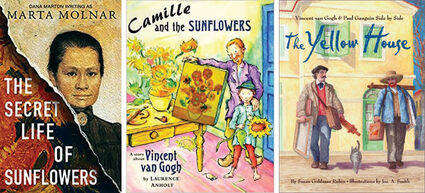Sunflowers
The TALE: Tehachapi Art, Literature and Entertainment
September 3, 2022
The sunflower, a native of North America, immigrated to Europe in 1510 in the cloth bags of Spaniards. Over 300 years later, sunflowers were immortalized in the paintings of Vincent Van Gogh. Van Gogh saw the brilliant yellow flower as a beacon of hope and gratitude.
In the late 1800s a group of unknown artists painted and sculpted with passion, while living very frugal and sometimes meager lives to fund their muse. They were passionate men, Matisse, Monet, Goupil, Seurat, Degas, Gauguin and Van Gogh among them. Society scorned and mocked these artists for trying to push art into new directions. Monet was criticized for buying a piece of land in Giverny, and said to be crazy when he started to dig holes to be made into ponds. He wanted to try painting lily pads. Van Gogh traveled to Arles and rented a bright yellow house. Dealing with continuous mental anguish, despair and depression, he sought the peace of nature spread out in fields of grain, and was desperate to capture light into his paintings.
The life of Vincent Van Gogh is highlighted in the new publication “The Secret Life of Sunflowers” by Marta Molnar. Using a unique blending of historical fact along with novel fiction, Molnar leads the reader between two centuries, one where Van Gogh is a struggling artist. The other, the life of a young present day auctioneer, Emsley, dealing with life’s challenges. Emsley’s Aunt Violet is a gregarious octogenarian, beloved by many, bedbound in the hospital after a bad fall. Emsley, dealing with both the betrayal of her business partners, and the threat of losing her auction house in Los Angeles, travels quickly to be by her aunt’s bedside in New York.
Amongst many of the intriguing events detailed is a package of yellowed letters Van Gogh sent his brother Theo, an old diary written by Theo’s wife Johanna, a live chick growing into full size inside Violet’s house, and a life-sized stuffed bear guarding the basement which houses a full sized working carousel. Have I made you curious? But please understand, the real life of Van Gogh is both a victory and tragedy. Molnar treats both with equal compassion. Emsley faces death that breaks her heart and love that heals it. Johanna passionately relates how she would not give up on Vincent and his paintings, especially after death, when no one would display them. And there is a window into how the many artists, renowned in our time in the museums and galleries around the world, were once unknown and languished in the rejection and dismissal of society.
In both “The Yellow House,” written by Susan Goldman Rubin (illustrated by Jos. A. Smith), and “Camille and the Sunflowers,” written and illustrated by Laurence Anholt, you will find the simple stories of Van Gogh both touching and enlightening. Anholt focuses on the story of Van Gogh going to Arles to the Yellow House. Vincent wished to make friends but most of the townsfolk did not trust the ragged man with the unstable mind. Fortunately, one family stepped forward and offered the artist kindness and friendship and in turn he painted the whole family in separate portraits. This is the time that Vincent also practiced putting light into his paintings of sunflowers. Today we have an array of 130 shades of yellow available to painters’ palettes, but Van Gogh had only three (yellow ochre, Veronese green and chrome yellow). Blending paints and sometimes adding white pigment, he managed to paint all his sunflowers with just those three yellows, an amazing feat! The sunflower is a happy flower, whose face follows the rays of the sun all day long. Vincent found comfort in them and filled his house in Arles with a dozen sunflower paintings.
In “The Yellow House” Rubin focuses both on Vincent filling his walls with the light of his paintings and telling the story of his friend Gauguin’s visit. Gauguin painted slowly, smoothing his colors into careful shapes. Compare that to Van Gogh and his Starry Night painting, with colors swirling with joy. Vincent tried so hard to embrace and express joy.
Why is it that in our world we produced so many starving artists, only giving them honor after their deaths? Artists, in the end, are like sunflowers that do not accept being minimized. If tossed aside, the sunflower roots. If planted in poor soil, it grows tall. As the sun moves, it turns to keep the light in its face. Sunflowers meant gratitude to Van Gogh, who strived so hard to find happiness and peace. We can be a sunflower in life, wherever our passions take us. Living gratitude, no matter where on life’s path, one becomes the light!
Good Books.
Good reading.
*Midge Lyn’dee is a fictional character used for the purpose of entertainment though the reviews are real and sincere.





